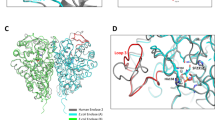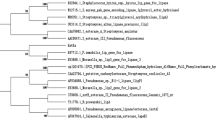Abstract
The glycolytic enzyme enolase of Staphylococcus aureus is a highly conserved enzyme which binds to human plasminogen thereby aiding the infection process. The cloning, over expression and purification of S. aureus enolase as well as the effect of various metals upon the catalytic activity and structural stability of the enzyme have been reported. The recombinant enzyme (rSaeno) has been purified to homogeneity in abundant amounts (60 mg/L of culture) and the kinetic parameters (Km = 0.23 ± 0.013 × 10−3 M; Vmax = 90.98 ± 0.00052 U/mg) and the optimum pH were calculated. This communication further reports that increasing concentrations of Na+ ions inhibit the enzyme while increasing concentrations of K+ ions were stimulatory. In case of divalent cations, it was found that Mg2+ stimulates the activity of rSaeno while the rest of the divalent cations (Zn2+, Mn2+, Fe2+, Cu2+, Ni2+ and Ca2+) lead to a dose-dependent loss in the activity with a total loss of activity in the presence of Hg2+ and Cr2+. The circular dichroism data indicate that other than Hg2+, Ni2+ and to a certain extent Cu2+, none of the other ions destabilized rSaeno. The inhibitory roles of fluorides, as well as neurotoxic compounds upon the catalytic activity of rSaeno, have also been studied. Conformational changes in rSaeno (induced by ions) were studied using partial trypsin digestion.










Similar content being viewed by others
Abbreviations
- BCIP:
-
5-bromo-4-chloro-3-indolyl phosphate
- E. coli :
-
Escherichia coli
- IPTG:
-
isopropyl β-d-1-thiogalactopyranoside
- NBT:
-
nitroblue tetrazolium
- Ni-NTA:
-
nickel-nitrilotriacetic acid
- PEP:
-
phosphoenolpyruvate
- PVDF:
-
polyvinylidene difluoride
- rSaeno:
-
hexa-histidine tagged S. aureus enolase
- S. aureus :
-
Staphylococcus aureus
- 2-PGA:
-
2-phospho-d-glycerate
- 6× His-tag:
-
hexa-histidine Tag
References
Agarwal S, Kulshreshtha P, Mukku DB and Bhatnagar R 2008 α-Enolase binds to human plasminogen on the surface of Bacillus anthracis. Biochim. Biophys. Acta, Proteins Proteomics 1784 986–994
Barnes LD and Stcllwagen E 1973 Enolase from the thermophile Thermus X-l. Biochemistry 12 1559–1565
Belli WA, Buckley DH and Marquis RE 1995 Weak acid effects and fluoride inhibition of glycolysis by Streptococcus mutans GS-5. Can. J. Microbiol. 41 785–791
Brewer JM 1981 Yeast enolase: Mechanism of activation by a metal ion. Crit. Rev. Biochem. 11 209–254
Brewer JM 1985 Specificity and mechanism of action of metal ions in yeast enolase. FEBS Lett. 182 8–14
Brewer JM and Weber G 1966 The effect of magnesium on some physical properties of yeast enolase. J. Biol. Chem. 16 3864–3869
Brown CK, Kuhlman PL, Mattingly S, Slates K, Calie PJ and Farrar WW 1998 A model of the quaternary structure of enolases, based on structural and evolutionary analysis of the octameric enolase from Bacillus subtilis. J. Protein Chem. 17 855–866
Carneiro CR, Postol E, Nomizo R, Reis LF and Brentani RR 2004 Identification of enolase as a laminin-binding protein on the surface of Staphylococcus aureus. Microbes Infect. 6 604–608
Chambers HF 2001 The changing epidemiology of Staphylococcus aureus? Emerg. Infect. Dis. 7 178–182
Curran TM, Buckley DH and Marquis RE 1994 Quasi-irreversible inhibition of enolase of Streptococcus mutans by flouride. FEMS Microbiol. Lett. 119 283–288.
Dutta S, Mukherjee D and Jarori GK 2015 Replacement of Ser108 in Plasmodium falciparum enolase results in weak Mg[II] binding: Role of a parasite-specific pentapeptide insert in stabilizing the active conformation of the enzyme. FEBS J. 282 2296–2308
Ehinger S, Schubert WD, Bergmann S, Hammerschmidt S and Heinz DW 2004 Plasmin [ogen]-binding α-enolase from Streptococcus pneumoniae: Crystal structure and evaluation of plasmin [ogen]-binding sites. J. Mol. Biol. 343 997–1005
Faller LD and Johnson AM 1974 Calorimetric studies of the role of magnesium ions in yeast enolase catalysis. Proc. Natl. Acad. Sci. USA 71 1083–1087
Guha-Chowdhury N, Clark AG and Sissons CH 1997 Inhibition of purified enolases from oral bacteria by fluoride. Mol. Oral. Microbiol. 12 91–97
Han X, Ding C, Chen H, Hu Q and Yu S 2012 Enzymatic and biological characteristics of enolase in Brucella abortus A19. Mol. Biol. Rep. 39 2705–2711
Howland RD, Vyas IL, Lowndes, HE and Argentieri TM 1980 The etiology of toxic peripheral neuropathies: In vitro effects of acrylamide and 2,5-hexanedione on brain enolase and other glycolytic enzymes. Brain Res. 202 131–142
Kornblatt MJ and Klugerman A 1989 Characterization of the enolase isozymes of rabbit brain: Kinetic differences between mammalian and yeast enolases. Biochem. Cell Biol. 67 103–107
Lebioda L, Zhang E, Lewinski K and Brewer JM 1993 Fluoride inhibition of yeast enolase: Crystal structure of the enolase–Mg2+–F–Pi complex at 2.6 Å resolution. Proteins: Struct., Funct., Bioinf. 16 219–225
Lee BH and Nowak T 1992 Influence of pH on the manganese[2+] activation of and binding to yeast enolase: A functional study. Biochemistry 31 2165–2171
Lee CY and Iandolo JJ 1988 Structural analysis of staphylococcal bacteriophage phi 11 attachment sites. J. Bacteriol. 170 2409–2411
Lee JH, Kang HK, Moon YH, Cho DL, Kim D, Choe JY and Robyt JF 2006 Cloning, expression, and characterization of an extracellular enolase from Leuconostoc mesenteroides. FEMS Microbiol. Lett. 259 240–248
Lu Q, Lu H, Qi J, Lu G and Gao GF 2012 An octamer of enolase from Streptococcus suis. Protein Cell 3 769–780
Maurer PJ and Nowak T 1981 Fluoride inhibition of yeast enolase. 1. Formation of the ligand complexes. Biochemistry 20 6894–6900
Pal-Bhowmick I, Sadagopan K, Vora HK, Sehgal A, Sharma S and Jarori GK 2004 Cloning, overexpression, purification and characterization of Plasmodium falciparum enolase. FEBS J. 271 4845–4854
Pancholi V 2001 Multifunctional α-enolase: Its role in diseases. Cell. Mol. Life Sci. CMLS 58 902–920
Pietkiewicz J, Kustrzeba-Wójcicka Irena and Wolna EB 1983 Purification and properties of enolase from carp [Cyprinus carpio]. Comparison with enolases from mammals’ muscles and yeast. Comp. Biochem. Physiol., B 75 693–698
Proctor RA 2012 Is there a future for a Staphylococcus aureus vaccine? Vaccine 30 2921–2927
Qin J, Chai G, Brewer JM, Lovelace, LL and Lebioda L 2006 Fluoride inhibition of enolase: Crystal structure and thermodynamics. Biochemistry 45 793–800
Raghunathan K, Harris PT, Spurbeck RR, Arvidson CG and Arvidson DN 2014 Crystal structure of an efficacious gonococcal adherence inhibitor: An enolase from Lactobacillus gasseri. FEBS Lett. 588 2212–2216
Sabri MI 1983 In vitro and in vivo inhibition of glycolytic enzymes by acrylamide. Neurochem. Pathol. 1 179–191
Sambrook J, Fritsch EF and Maniatis T 1989 Molecular cloning. A laboratory manual, vol. 1 (NY: Spring Harbor Laboratory Press, Cold Spring Harbor) pp. 1339–1341
Shen TY and Westhead EW 1973 Divalent cation and pH-dependent primary isotope effects in the enolase reaction. Biochemistry 13 3292–3297
Sreerama N and Woody RW 2000 Estimation of protein secondary structure from circular dichroism spectra: Comparison of CONTIN, SELCON, and CDSSTR methods with an expanded reference set. Anal. Biochem. 287 252–260
Steinberg JP, Clark CC and Hackman BO 1996 Nosocomial and community-acquired Staphylococcus aureus bacteremias from 1980 to 1993: Impact of intravascular devices and methicillin resistance. Clin. Infect. Dis. 23 255–225
Vinarov DA and Nowak T 1998 pH dependence of the reaction catalyzed by yeast Mg-enolase. Biochemistry 37 15238–15246
Wang T and Himoe A 1974 Kinetics of the rabbit muscle enolase-catalyzed dehydration of 2-phosphoglycerate fluoride and phosphate inhibition. J. Biol. Chem. 249 3895–3902
Wold F 1971 18 enolase; in The enzymes vol. 5 (Academic Press) pp. 499–538
Wold F and Ballou CE 1957 Studies on the enzyme enolase I. Equilibrium studies. J. Biol. Chem. 227 301–312
Wu Y, Wang C, Lin S, Wu M, Han L, Tian C and Zang J 2015 Octameric structure of Staphylococcus aureus enolase in complex with phosphoenolpyruvate. Acta Crystallogr., Sect. D: Biol. Crystallogr. 71 2457–2470
Zhao J, Carmody LA, Kalikin LM, Li J, Petrosino JF, Schloss PD and LiPuma JJ 2012 Impact of enhanced Staphylococcus DNA extraction on microbial community measures in cystic fibrosis sputum. PLoS One 7 e33127
Acknowledgements
This work was supported by the financial assistance from DST, Govt. of India to Dr Malabika Biswas (Sanction No. EMR/2015/002229). Mr Vijay Hemmadi is a recipient of Junior Research Fellowship from DST, Govt. of India. Mr Avijit Das is a recipient of Institute Fellowship from BITS-Pilani, K. K. Birla Goa campus.
Author information
Authors and Affiliations
Corresponding author
Additional information
Communicated by Saumitra Das.
Corresponding editor: Saumitra Das
Electronic supplementary material
Below is the link to the electronic supplementary material.
Rights and permissions
About this article
Cite this article
Hemmadi, V., Das, A., Chouhan, O.P. et al. Effect of ions and inhibitors on the catalytic activity and structural stability of S. aureus enolase. J Biosci 44, 90 (2019). https://doi.org/10.1007/s12038-019-9912-4
Received:
Accepted:
Published:
DOI: https://doi.org/10.1007/s12038-019-9912-4




